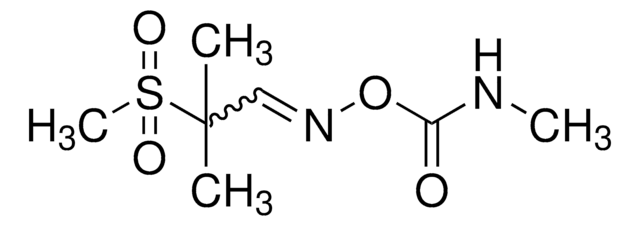CRM69033
Aldicarb-sulfone
mixture of E/Z - isomers, certified reference material, TraceCERT®, Manufactured by: Sigma-Aldrich Production GmbH, Switzerland
About This Item
Recommended Products
grade
certified reference material
TraceCERT®
Quality Level
product line
TraceCERT®
shelf life
limited shelf life, expiry date on the label
manufacturer/tradename
Manufactured by: Sigma-Aldrich Production GmbH, Switzerland
storage temp.
2-8°C
SMILES string
CNC(ON=CC(C)(C)S(C)(=O)=O)=O
InChI
1S/C7H14N2O4S/c1-7(2,14(4,11)12)5-9-13-6(10)8-3/h5H,1-4H3,(H,8,10)
InChI key
YRRKLBAKDXSTNC-UHFFFAOYSA-N
Looking for similar products? Visit Product Comparison Guide
Related Categories
General description
Certified content by quantitative NMR incl. uncertainty and expiry date are given on the certificate.
Download your certificate at: http://www.sigma-aldrich.com
Aldicarb-sulfone is a metabolite of the systemic carbamate pesticide- aldicarb, used widely against insects, nematodes, and mites for a variety of crops such as citrus fruits, cotton, sugar beet, pecan, and peanut crops.
The parent compound aldicarb (measured inclusive of its sulfoxide and its sulfone) is not approved for its use in the European Union (EU) as a plant protection agent. This is in accordance with Regulation (EC) No 1107/2009 of the European Parliament and repealing Council Directives 79/117/EEC and 91/414/EEC. But a default maximum residue limit (MRL) of 0.02 mg/kg and 0.05 mg/kg is set for the presence of aldicarb in fresh/frozen fruits and tree nuts respectively as per Reg. (EU) No 310/2011.
Application
The aldicarb-sulfone CRM may also find given below uses:
- Study of aldicarb and its oxidation degradation products using high-performance liquid chromatography coupled to mass spectrometric and UV detection
- Simultaneous multi-residue analysis of 36 pesticides in spinach and cauliflower samples using multi-walled carbon nanotubes (MWCNTs) as an adsorbent for the reversed-dispersive solid-phase extraction (r-DSPE) and liquid chromatography-tandem mass spectrometry (LC-MS/MS) for the identification and quantification
- Analysis of 102 pesticide residues in green tea samples using a modified QuEChERS method combined to high-performance liquid chromatography-tandem mass spectrometry (HPLC-MS/MS)
- Development and validation of a method for determination of 58 pesticides and their metabolite residues in egg samples by a multi-functional filter (MFF) based QuEChERS clean-up and ultra-high performance liquid chromatography-tandem mass spectrometric (UHPLC-MS/MS) analysis
- Evaluation of different adsorbents to clean-up edible oil samples of sunflower, olive, and soya for the simultaneous analysis of oil samples for 169 pesticides by ultra high-performance liquid chromatography-triple quadrupole mass spectrometry (UHPLC-QqQ-MS/MS)
- Method development for analyzing 34 pesticide residues from 9 different classes of chemical compounds in human serum samples using salt-assisted acetonitrile extraction and high-performance liquid chromatography-quadrupole time of flight-tandem mass spectrometric (HPLC-QTOF-MS) quantification
Recommended products
Legal Information
Signal Word
Danger
Hazard Statements
Precautionary Statements
Hazard Classifications
Acute Tox. 2 Dermal - Acute Tox. 2 Inhalation - Acute Tox. 2 Oral - Aquatic Acute 1
Storage Class Code
6.1A - Combustible acute toxic Cat. 1 and 2 / very toxic hazardous materials
WGK
WGK 3
Flash Point(F)
Not applicable
Flash Point(C)
Not applicable
Choose from one of the most recent versions:
Certificates of Analysis (COA)
Don't see the Right Version?
If you require a particular version, you can look up a specific certificate by the Lot or Batch number.
Already Own This Product?
Find documentation for the products that you have recently purchased in the Document Library.
Our team of scientists has experience in all areas of research including Life Science, Material Science, Chemical Synthesis, Chromatography, Analytical and many others.
Contact Technical Service









